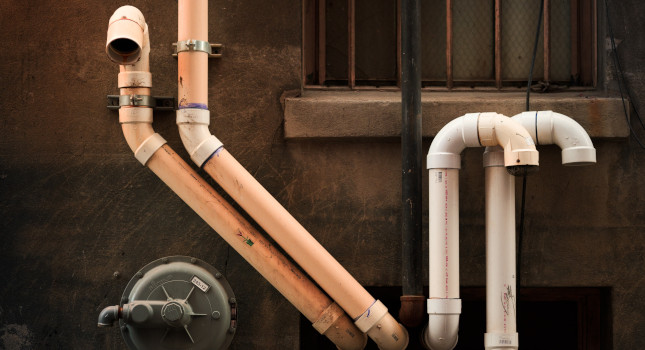A robust maintenance plan will expand life expectancy of nonmetallic expansion joints

Expansion joints are flexible connectors used to reduce vibration, dampen sound, and accommodate movement in industrial piping systems for pressurized fluids (see Figure 1). These systems are subject to movement from pressure or vacuum, temperature gradients, equipment vibration, their own weight, and structural settlement. To compensate for this movement, expansion joints are typically installed at the suction or discharge side of pumps, and at directional changes and long runs of piping.
There are two primary types of expansion joints—metal and nonmetallic or elastomer. Metal expansion joints are constructed in a bellows configuration from thin-gauge material designed to absorb mechanical and thermal movement.
Elastomer expansion joints, by contrast, are fabricated from natural or synthetic rubber and fabric. Consisting of an inner elastomeric tube fused to a metal-reinforced fabric body and an elastomeric cover, these expansion joints accommodate greater pipe movement and provide greater abrasion resistance than metal joints. Visible signs of wear and fatigue, including exterior surface cracking, blistering, deformation and delamination, exposure of metal or fabric reinforcement, ply separation of the cover, rubber deterioration, and leakage, can alert observant users to potential failure.
A robust preventative maintenance program for elastomer expansion joints can improve both plant safety and the mechanical integrity of equipment. Such a program includes a comprehensive, systematic survey of all expansion joints, stocking the proper types and levels of inventory, periodic follow-up inspections, analysis of prematurely failed joints, and ongoing training for plant personnel.
Program objectives
The objective of such surveys is to prevent premature failures, which can become even more costly than replacing the joints. For smaller plants this may involve 50 or so joints, but for larger ones the number can exceed 300. Depending on the size of the facility, a survey could take up to three days to gather the relevant data for each of its expansion joints, including location, orientation, inside diameter, and face-to-face dimensions, as well as any misalignment and offsets, either lateral or angular. The style and general condition of each joint also should be noted and recorded as still being serviceable, requiring reinspection in six months or requiring immediate replacement.
A summary of all the expansion joints can then be compiled into a single document. In addition to joints in service, those in inventory should be surveyed as well to assure the proper types and sufficient number of spares are on hand for both critical and noncritical applications. Spares also should be checked to make sure the manufacturer’s allowable shelf life has not expired. Stored under ideal conditions, the potential shelf life of a nonmetallic expansion joint is five years. Beyond this date, signs of degradation such as embrittlement, cracking, and restriction of movement may begin to appear. Expansion joints should be stored in a cool and dry area protected from ultraviolet light of the sun. They should rest upright on their flange faces with nothing placed on top of them.
After the initial survey has been conducted, all expansion joints should be reinspected, ideally prior to planned shutdowns or scheduled maintenance. Those exhibiting signs of wear can then be replaced from inventory and restocked. Replacing failed or damaged expansion joints not only protects the piping systems in which they are installed, but also provides critical information regarding system conditions at their locations.
Failure analysis
Expansion joint failures are caused by a variety of factors. As noted, failures of nonmetallic expansion joints, especially elastomeric types, are usually preceded by perceptible warning signs. For example, the arch inversion shown in Figure 3 indicates system vacuum exceeded the joint’s specified expansion value. Another warning sign is cracking at the base of the arch, which indicates the joint has been over-elongated and should be replaced with one of the proper length. If the arch is soft and easily deformed, the tube has been chemically attacked or cracked from the inside (Figure 2). In this case the compatibility of the tube and media needs to be reexamined.
Yet another warning sign is ply separation on the outside of the cover. This is an indication the joint has been subjected to excessive movement. When it is replaced, control units should be considered to limit movement to the manufacturer’s rated value. If there is leakage at the flanges, a retightening may be needed since the material in nonmetallic expansion joints can tend to settle. If leakage persists, make sure the joint is mated against a flat-faced flange; otherwise, a gasket may be needed to create a flat surface on the flange.
Expansion joints can burst, yet this rarely occurs since most are designed with 3:1 or 4:1 safety factors for burst pressures in excess of 1,000 psi. One factor commonly overlooked, however, is the existing versus original condition of an expansion joint.
For example, in general water service with a relatively low flow rate, ambient temperature, stable system pressure, and minimal movement, an expansion joint could theoretically last up to 20 years. Other applications, such as flue gas desulphurization systems, pump highly abrasive slurry media at high flow rates, accelerating joint wear. Every application is different, so failed expansion joints should be removed and assessed for the root causes of failure.
Elastomer expansion joints tend to fail from the inside, where flow conditions can adversely affect the entire assembly. Of the three basic components of an expansion joint, the tube is the most critical, serving as both the physical and chemical boundary between the body and the media. If the tube is compromised, the body that provides the joint’s strength can be exposed to the media, potentially causing it to degrade. Therefore, it is critical to note the condition of the tube when examining a failed expansion joint. In abrasive applications, the media can wear through the tube and body of a joint to the point where only minimal pressure can cause it to leak or burst. In other instances the tube may have hardened from excessive temperatures, causing it to lose its resilience and crack under dynamic movement (see Figure 4).
Understanding the root causes of expansion joint failures can provide useful information about the systems in which they were installed, but it is preferable to prevent such failures in the first place. The challenge is to develop and deploy a maintenance program to find the visible indicators of potential joint failures and take the necessary preventive action. Frequency of inspections will vary with application conditions. Critical path and high-risk systems may require fairly frequent inspection, whereas less critical ones can be inspected biannually or even annually.
Field surveys gather the necessary information regarding a given expansion joint in its application, serving as a benchmark against which to assess its condition in future inspections. Combining survey information with root-cause failure analysis completes the expansion joint data set, providing its history and predicting its future performance.
To be effective, preventive maintenance programs for nonmetallic expansion joints also should include ongoing training on proper joint installation and removal, visual inspections, proper bolting, lifting and lugging, troubleshooting, and dimensional verification for replacements. This training will help ensure that all plant personnel are able to detect and interpret the signs of potential joint failures and prevent them from occurring.
Sherwin Damdar is the project lead for expansion joints and Stephen Cramb is applications engineer for expansion joints for Garlock Sealing Technologies, Palmyra, N.Y.
